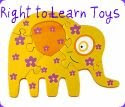
Educational Toys and Life Skills
Educational toys not only promote developmental skills in children. They also help children acquire and improve essential life skills. Creativity, self-confidence, independence, responsibility, and integrity can all be cultivated through the use of carefully selected educational toys.
Creativity
One hallmark of educational toys is how well they support creative, open-ended play. A tray of wooden food can inspire a child to spend a whole afternoon running a pretend restaurant or planting and harvesting crops on a pretend farm. A set of blocks can be turned into a tower, a road system, a fort, a car, or even different animals. And the possibilities for a pound of modeling clay are endless! The more time a child spends exploring all the different things a toy can become, the more developed the child's powers of imagination will be. This fosters an open-mindedness to new possibilities that will help the child think of creative and innovative solutions to any challenges he or she ends up facing as an adult.
Self-Confidence
One way to build self-confidence is through play that encourages a child to assert him or herself. Singing, performing, and acting in front of an audience all help children assert themselves both in the planning stage and during an actual performance. Children also learn to assert themselves by acting out scenarios or performing informally with peers. Open-ended toys such as musical instruments and dress-up clothes and props encourage this type of play.
Taking risks that pay off will also develop a child's self-confidence. Susan G. Solomon, author of American Playgrounds: Revitalizing Community Space, notes that "Children need a chance to take acceptable risks, learn cause and effect, make choices and see consequences. If they don't learn to take risks, we'll lose a generation of entrepreneurs and scientists." To take such risks, children must develop powers of risk assessment and decision making so that they can be sure that the risks they plan to take are, in fact, acceptable. The act of riding and controlling large toys such as bicycles requires children to calculate physical risks. The logic needed to play certain strategy-based board games like Monopoly, chess, and checkers involves risk assessment such as whether or not to invest in a property or risk one piece for a future, greater gain.
To improve their ability to calculate risk, children should also develop their decision-making skills. Science and engineering kits can help by requiring children to use observations and directions to make decisions about how to run an experiment or build a working machine. Puzzles and building construction sets can also hone this skill.
Independence
In general, allowing children to direct their own play and be in charge of what to do during their free time helps them become more self-sufficient and resilient. In particular, certain educational toys foster skills such as problem solving, taking charge of a situation, and leadership. One aspect of being independent is being able to solve a problem on your own. Working with a construction toy system allows a child to explore different solutions to the challenge of building various items. Logical challenges faced on your own, such as figuring out how to use a set of pattern blocks to replicate certain complicated patterns, also build problem-solving skills.
Another aspect of being independent is taking charge of a situation. This can be as simple as providing your baby with two toy choices and allowing the baby the autonomy to make his or her own decision about which to play with. Beyond that, you can also encourage the development of independence by allowing your child to direct what roles you will take on when playing with your child or letting your child be in charge of how a toy will be played with. Providing your child with open-ended play sets such as farms, fire and police stations, pirate ships, tree houses, and train stations creates a situation where your child can control what scenarios he or she will act out that day.
A third aspect of being independent is taking a leadership role. While unit blocks and communal building sets of oversized hollow wood blocks, huge foam blocks, or sturdy cardboard blocks can foster cooperation skills, they can also offer opportunities for one child to lead others in a positive way to build a specific construction that that child has in mind. Educational toys can also help children become self-motivated and self-directed so that they can lead themselves to accomplishments without always relying on outside support and affirmation.
Responsibility
To become good citizens, all children should develop a sense of personal, societal, and environmental responsibility. In general, trusting children to take good care of their toys, to play nicely with them and put them back where they belong when play is done, can begin to foster a sense of responsibility. At the most basic level, a chart such as Melissa and Doug's Magnetic Responsibility Chart can help a child keep track of his or her personal obligations. Beyond that, specific toys can develop other kinds of responsibility.
When a child is provided with an open-ended toy such as a construction set that must be assembled by the child, he or she will take on the personal responsibility of following the directions and making sure the toy is put together correctly. This will train the child to take a sense of pride and personal responsibility in any future jobs he or she is expected to do. And, when a child takes care of a doll or pretend pet, he or she also develops a sense of personal responsibility for fulfilling his or her obligations to someone else.
Role-playing of obligations can extend to creating a sense of responsibility to society. When a child pretends that he or she is a construction worker or a doctor, that child is practicing taking on adult responsibilities that must be fulfilled if people are to live together in communities. Such role-playing socializes the child and allows him or her to get used to the idea of becoming a contributing member to such a community once he or she is grown.
Finally, science kits that encourage children to study the earth can educate children about why people must take care of animals, land, resources, and so forth. Plus, toys that are crafted from sustainable materials (such as Plan Toys) or bioplastics (such as Green Toys), or designed to use recycled materials (such as the Uberstix Scavenger sets), encourage a respect for the conservation of natural resources. This in turn leads to a developed sense of responsibility for caring for the environment.
Integrity
Educational toys can also help children develop integrity. Using costumes and props to role-play situations such as customer and server can help children practice politeness and manners. Acting out scenarios such as taking care of an injured doll or animal can foster compassion and empathy. And playing competitive games fairly by taking turns and following the rules develops a child's appreciation for right and wrong.
The educational benefit of toys for child development cannot be underestimated. The childhood pursuit for play and discovery continues into adulthood. Children develop fascination about their surroundings from playing with toys and continue to pick up hobbies late into their adult life.
About Kids Toy Club
Kids Toy Club is an online provider of
educational toys that is dedicated to adding value to the money its customers spend. Understanding that educational toy purchases are an investment in a child's future, Kids Toy Club makes the effort to provide quality products and useful
information about the relationship between toys and child development.
























